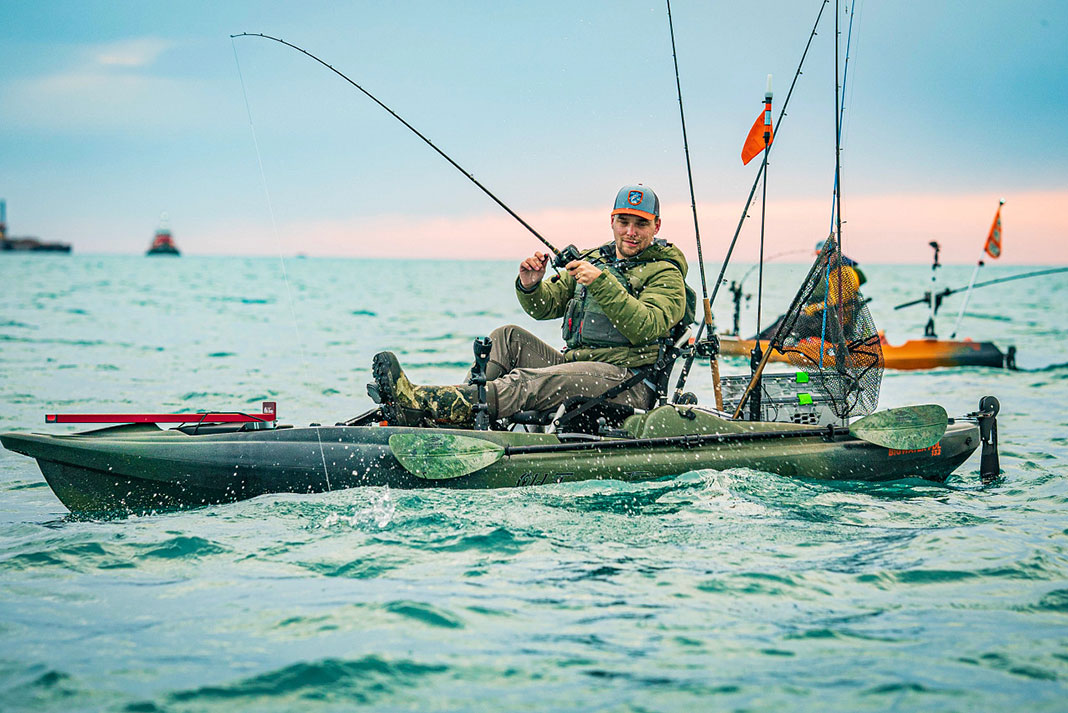Bottom fishing is often written off as a no brainer, unless you target the reefs and wrecks for brute grouper and snapper. Bouncing a sinker and bait on a heavy rod may seem simple, but it’s not so easy to retrieve big, bottom-dwelling fish living deep in structure. The skills learned on denizens of the deep translate to bottom feeders from sea bass to crappie.
How to Reel In Reef-Dwelling Bottom Fish
Pensacola, Florida guide Brandon Barton targets red snapper and grouper with heavy tackle and a light touch. While dropping a chunk of cut bait on a dropper rig and sinker would get the bait to the fish, the traditional technique makes it hard to get the fish out of the reef.
Instead, Barton uses an unweighted rig and chums the fish to the boat. Barton starts by searching the structure with his fish finder. “When I mark fish, I drop chunks of cut bonita to draw them higher in the water column,” he says.

With fish on the screen, Barton positions the kayak downwind or down current from the mark. Then, he hides a light-wire circle hook in a chunk of bait and drops it to the fish. For a perfect presentation, the fish can’t see the hook or the leader. “Fluorocarbon leader is virtually invisible under water and lighter test allows the bait to sink naturally,” he says. If the fish feels any resistance it will spit the bait.
Using lighter leader and a smaller hook result in more bites from finnicky fish. Many times, the bite will shut down as the fish get suspicious. “Using lighter line allows me to catch more fish because they don’t get spooked so easily.”
Stay ready to pounce
Bottom bouncers warn against fishing the rod from the holder. A big fish can slurp the bait off the hook without the angler noticing. It’s best to hold the rod, lightly pinching the line, to react immediately.
When bottom fishing, position the boat directly over the rig with the line straight up and down to reduce slack and increase sensitivity. And, it’s easier to work a fish straight up than risking fighting it at an angle where it can run to the nearest snag.
Once the fish takes the bait, Barton turns on heavy pressure. “Use heavy drag and keep the rod pointing towards the bow so the fish doesn’t flip the kayak,” he warns.
Maintain upward pressure
Barton recommends a rod with stiff backbone and fast tip to lift the fish from the bottom. “Keep the rod butt jammed in your stomach and use your back instead of fighting the fish with your arms,” he adds. Quick pumps of the rod keep the fish heading towards the surface. Any pause in the fight, the fish can turn around and break the line in the structure.

The fight will be over before it is over if the knot connecting the leader to the mainline gets stuck in the rod eyes. “I use the FG knot to smoothly pass through the guides and around the reel spool.”
Hooking a fish in deep water gives it a lot of time to get off the hook. Constant pressure and continual cranking towards the surface are the best way to get the fish into the kayak.
Trophy time
When the fish breaks the surface, and the rig is a rod’s length from the rod tip, scoop the trophy with a net or swing it into the kayak. The greatest sin is cranking the fish too far and then chasing it around the air until it eventually flips off the hook and flops back into the water.
This article was first published in the Fall 2019 issue of Kayak Angler. Subscribe to Kayak Angler Magazine’s print and digital editions, or browse the archives.
It’s a battle to get big, bottom-dwelling fish out of the reef. | Feature photo: Jeffrey Fortuna








